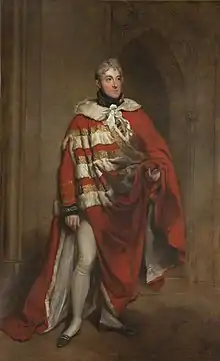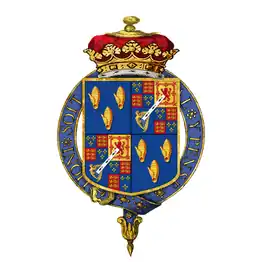William Vane, 1st Duke of Cleveland
William Henry Vane, 1st Duke of Cleveland, KG (27 July 1766 – 29 January 1842), styled Viscount Barnard until 1792 and known as The Earl of Darlington between 1792 and 1827 and as The Marquess of Cleveland between 1827 and 1833, was a British landowner and politician.
The Duke of Cleveland | |
|---|---|
 William Vane wearing the parliamentary robes of an earl. By Arthur William Devis, 1810. | |
| Lord-Lieutenant of County Durham | |
| In office 1792–1842 | |
| Monarch | |
| Preceded by | The Earl of Darlington |
| Succeeded by | The Marquess of Londonderry |
| Personal details | |
| Born | William Harry Vane 27 July 1766 |
| Died | 29 January 1842 (aged 75) St James's Square, Westminster, London |
| Nationality | British |
| Spouse(s) | Lady Catherine Powlett
(m. 1787; died 1807)Elizabeth Russell (m. 1813) |
| Alma mater | Christ Church, Oxford |


Background and education
Styled Viscount Barnard from birth, he was the son of Henry Vane, 2nd Earl of Darlington, son of Henry Vane, 1st Earl of Darlington and Lady Grace FitzRoy, daughter of Charles FitzRoy, 2nd Duke of Cleveland, son of King Charles II by his mistress Barbara Palmer, 1st Duchess of Cleveland. His mother was Margaret Lowther, daughter of Robert Lowther, Governor of Barbados, and sister of James Lowther, 1st Earl of Lonsdale. He was baptised at the Chapel Royal at St James's Palace (with the names William Harry which he later changed to William Henry). He was educated at Christ Church, Oxford.[2]
Public life
Barnard was Whig Member of Parliament for Totnes from 1788 to 1790[2][3] and for Winchelsea from 1790 to 1792.[2][4] The latter year he succeeded his father in the earldom and took his seat in the House of Lords. He also succeeded his father as Lord Lieutenant of County Durham, a post he held until his death.[5] In 1810 he successfully laid claim to the Pulteney Estate in Bath after the Countess of Bath died intestate in 1808.[6] In 1827 he was created Marquess of Cleveland,[7] a revival of the Cleveland title held by his ancestors. He was Bearer of the Third Sword at King William IV's coronation on 8 September 1831.[8] In 1833 he was made Baron Raby, of Raby Castle in the County Palatine of Durham, and Duke of Cleveland.[9] He was further honoured when he was made a Knight of the Garter in 1839.[10]
His promotions through the ranks of the peerage were not uncontroversial. Greville noted in his diary on 8 September 1831:
”Howe told me yesterday morning in Westminster Abbey that Lord Cleveland is to be made a duke, though it is not yet acknowledged if it is to be so. There has been a battle about that; they say that he got his boroughs to be made a marquis and got rid of them to be made a duke.”[11]
According to the Legacies of British Slave-Ownership at the University College London, Cleveland was awarded a payment as a slave trader in the aftermath of the Slavery Abolition Act 1833 with the Slave Compensation Act 1837. The British Government took out a £15 million loan (worth £1.8 billion in 2020) with interest from Nathan Mayer Rothschild and Moses Montefiore which was subsequently paid off by the British taxpayers (ending in 2015). Cleveland was associated with "T71/898 Barbados claim no. 3184 (Lowther)", he owned 233 slaves in Barbados and received a £4,854 payment at the time.[12]
Family
Cleveland married his cousin, Lady Catherine Powlett (1766–1807), daughter of Harry Powlett, 6th Duke of Bolton, on 17 September 1787 at her father's seat, Hackwood Park. They had eight children:
- Henry, Earl of Darlington, later 2nd Duke of Cleveland (1788–1864).
- Lady Louisa Catherine Barbara Vane (1791–1821), married Major Francis Forester and had issue.
- Lord William Vane, later 3rd Duke of Cleveland (1792–1864).
- Lady Caroline Vane (born and died 1795).
- Lady Augusta Henrietta Vane (1796–1874), married Mark Milbank and had issue, including Sir Frederick Milbank, 1st Baronet.
- Lady Arabella Vane (1801–1864), married Richard Arden, 3rd Baron Alvanley.
- Lord Harry Vane, later 4th Duke of Cleveland (1803–1891).
- Lady Laura Vane (1807–11 November 1882), married Lieutenant-Colonel William Henry Meyrick and had issue.
After his first wife's death in London in June 1807, Cleveland married as his second wife, Elizabeth Russell (c. 1777–1861), daughter of Robert Russell, on 27 July 1813. There were no children from this marriage. Cleveland died at St James's Square, Westminster, London, in January 1842, aged 75, and was buried at Staindrop, County Durham. His eldest son Henry succeeded in the dukedom. The Duchess of Cleveland died in January 1861.[2]
References
- Debrett's Peerage, 1968, p.115, which omits appaumée, useful in differentiating from Fane arms; concerning appaumée Cussans (1898) states: "In blazoning a Hand, besides stating what position it occupies, and whether it be the dexter or sinister, and erased or couped, it must be mentioned whether it be clenched or appaumé". (Cussans, John, Handbook of Heraldry, 2nd Edition, London, 1868, p.47 , p.92)
- thepeerage.com Sir William Henry Vane, 1st Duke of Cleveland
- Leigh Rayment's Historical List of MPs – Constituencies beginning with "T" (part 2)
- Leigh Rayment's Historical List of MPs – Constituencies beginning with "W" (part 4)
- leighrayment.com Peerage: Cleveland to Columbers
- Baggs, A P; Bolton, Diane K; Hicks, M A; Pugh, R B (1980). "'Hornsey, including Highgate: Other estates', in A History of the County of Middlesex: Volume 6, Friern Barnet, Finchley, Hornsey With Highgate". London: British History Online. pp. 146–149. Retrieved 14 July 2020.
- "No. 18397". The London Gazette. 18 September 1827. p. 1955.
- "No. 18848". The London Gazette. 13 September 1831. p. 1865.
- "No. 19013". The London Gazette. 15 January 1833. p. 97.
- "No. 19726". The London Gazette. 19 April 1839. p. 832.
- Charles C. F. Greville, A Journal of the Reigns of King George IV and King William IV, volume II (London, Longmans Green & Co, 1874), at page 192
- "William Harry Vane, 1st Duke of Cleveland [Earl of Darlington; Marquess of Cleveland]". University College London. Retrieved on 20 March 2019.
External links
- Hansard 1803–2005: contributions in Parliament by the Duke of Cleveland
- . Dictionary of National Biography. London: Smith, Elder & Co. 1885–1900.
| Parliament of Great Britain | ||
|---|---|---|
| Preceded by Sir Philip Jennings-Clerke, Bt Henry Phipps |
Member of Parliament for Totnes 1788–1790 With: Henry Phipps |
Succeeded by William Powlett Powlett Francis Buller Yarde |
| Preceded by John Nesbitt William Nedham |
Member of Parliament for Winchelsea 1790–1792 With: Richard Barwell |
Succeeded by Richard Barwell Sir Frederick Fletcher-Vane, Bt |
| Honorary titles | ||
| Preceded by The Earl of Darlington |
Lord Lieutenant of County Durham 1792–1842 |
Succeeded by The Marquess of Londonderry |
| Vacant Title last held by The Earl of Darlington |
Vice-Admiral of Durham 1795–1842 | |
| Peerage of the United Kingdom | ||
| New title | Duke of Cleveland 1833–1842 |
Succeeded by Henry Vane |
| New title | Marquess of Cleveland 1827–1842 |
Succeeded by Henry Vane |
| New title | Baron Raby 1833–1842 |
Succeeded by Henry Vane |
| Peerage of Great Britain | ||
| Preceded by Henry Vane |
Earl of Darlington 1792–1842 |
Succeeded by Henry Vane |